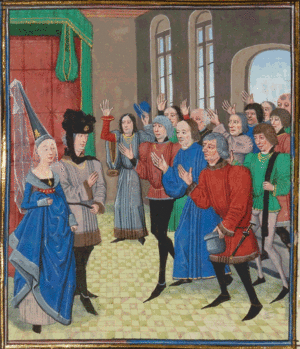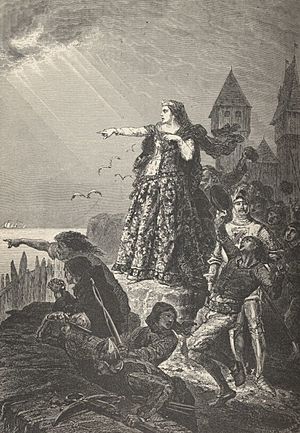Joanna of Flanders facts for kids
Quick facts for kids Joanna of Flanders |
|
|---|---|
 |
|
| Duchess consort of Brittany | |
| Tenure | 30 April 1341–16 September 1345 |
| Born | c. 1295 |
| Died | September 1374 (aged 78–79) |
| Spouse | John of Montfort |
| Issue |
|
| House | Dampierre |
| Father | Louis I, Count of Nevers |
| Mother | Joan, Countess of Rethel |
Joanna of Flanders (born around 1295 – died September 1374) was a brave and important woman in French history. She became the Duchess of Brittany when she married John of Montfort.
Joanna spent much of her life fighting for her husband's and later her son's right to rule Brittany. This right was challenged by another powerful family, the House of Blois. This led to a long conflict called the War of the Breton Succession.
Joanna was known for her strong and determined personality. She took charge of her family's side after her husband was captured. She showed great skill as a military leader. Later in her life, she was held in Tickhill Castle in England by order of King Edward III.
Many people praised Joanna for her courage. The writer Jean Froissart admired her energy. The historian David Hume called her "the most extraordinary woman of the age."
Contents
Early Life and Family
Joanna was the daughter of Louis I, Count of Nevers and Joan, Countess of Rethel. She was also the sister of Louis I, Count of Flanders. In March 1329, she married John of Montfort.
John of Montfort believed he should be the Duke of Brittany. However, his claim was challenged by his cousin, Joan of Penthièvre, and her husband, Charles of Blois.
Joanna and John had two children:
- John IV, Duke of Brittany (born 1339 – died 1399)
- Joan of Brittany, Baroness of Drayton (born 1341 – died after October 20, 1399). She married Ralph Basset, 4th Baron Basset de Drayton.
The War for Brittany's Throne
When John III, Duke of Brittany died in 1341, he had no children. This caused a big argument over who should rule Brittany next. For years, he had tried to stop his stepmother's children from inheriting. He even named his niece, Joan of Penthièvre, as his heir.
But just before he died, Duke John III made up with his half-brother, John of Montfort. He then suggested John of Montfort should be the next duke. So, after Duke John III's death, two families wanted to rule Brittany. These were the House of Montfort, led by John and Joanna, and the House of Blois, led by Charles of Blois and Joan of Penthièvre.
John of Montfort went to Paris to speak with King Philip VI of France. King Philip was Charles of Blois's uncle. Despite promising John of Montfort safety, the King put him in prison. King Philip and the French courts then decided that Joan and Charles were the rightful rulers of Brittany.
Joanna Leads the Fight
After her husband was imprisoned, Joanna announced that her young son would lead their family's side. She quickly gathered an army and captured the town of Redon. From there, she went to Hennebont to get it ready for a siege.
Charles of Blois soon arrived in 1342 and began to attack Hennebont. Joanna sent a knight, Amaury de Clisson, to ask King Edward III of England for help. King Edward was happy to help because he was fighting King Philip for the French crown. Having Brittany as an ally would be very useful for his future battles. He sent ships with soldiers led by Sir Walter Manny to help Hennebont.
The Siege of Hennebont
During the siege of Hennebont, Joanna herself put on armor and helped defend the town. She encouraged everyone to fight bravely. She even told the women to "cut their skirts and take their safety in their own hands."
One day, she looked from a tower and saw that the enemy camp was almost empty. She quickly led 300 men on a surprise attack. They burned Charles's supplies and destroyed his tents. After this brave act, she became known as "Jeanne la Flamme" (Joanna the Flame).
When Charles's army realized what was happening, they tried to stop her retreat to the town. But Joanna and her knights rode quickly to Brest. This drew some of Charles's soldiers away from Hennebont. After securing Brest, she gathered more supporters. She then secretly returned to Hennebont, avoiding Charles's forces, and re-entered the town with her reinforcements.
Charles of Blois tried to starve the people inside Hennebont. During a long meeting, the bishop of Leon tried to convince Joanna to give up. But from the window, she saw Sir Walter Manny's fleet from England sailing closer. Hennebont was made stronger with the English soldiers and held out. Charles was forced to leave, but he tried to capture other towns in Brittany to isolate Joanna. When he returned, he still failed to capture Hennebont.
Fighting Back
Joanna sailed to England to ask King Edward for more help. He provided more soldiers. However, the English fleet was attacked on its way to Brittany by Charles of Blois's ally, Louis of Spain.
In a fierce battle, sailors and knights fought hand-to-hand. Louis's men tried to board Joanna's ship. According to the writer Froissart, Joanna fought personally "with the heart of a lion." She used a sharp glaive (a type of spear) and fought fiercely. Eventually, the English forces defeated Louis's ships and landed near Vannes. Joanna's forces then captured Vannes, attacked Rennes, and tried to break the siege of Hennebont.
After this, Joanna took less direct part in the fighting. Her family's side was now being led by English military leaders. Since neither side could win completely, a truce (peace agreement) was made in 1343. Her husband, John, was released, and the fighting stopped for a while. He was later imprisoned again but escaped and continued the war. When her husband died in 1345, Joanna once again became the leader of the Montfort party. She fought to protect her son John V's rights against the House of Blois. In 1347, English forces fighting for her captured Charles of Blois in battle.
Later Life and Confinement
By this time, Joanna and her son were living in England. After being welcomed with honor at first, she was later held captive by order of King Edward III. She spent the rest of her life in confinement at Tickhill Castle and other places.
King Edward III placed her under the care of several people over the years. Some historians have suggested she might have had a mental illness. However, more recent studies do not find strong proof of this. It is more likely that King Edward III imprisoned her to increase his own power in Brittany.
Joanna lived long enough to see her son, John IV, Duke of Brittany, finally win against the House of Blois in 1364. But she never returned to Brittany. The last mention of the duchess and her guardian is from February 14, 1374. It seems she died that same year.
Joanna's Legacy
Joanna was later seen as an example of a strong, fighting woman in Brittany. Some even think she might have influenced Joan of Arc. The writer Jean Froissart said she "had the courage of a man and the heart of a lion." The historian David Hume described her as "the most extraordinary woman of the age."
Later, women's rights supporters also saw her as a role model. Harriet Taylor Mill mentioned her as one of the "heroic chatelaines" (women who defended castles) of the Middle Ages. Amelia Bloomer also called her one of the "heroic women" of her time.
Joanna was also celebrated in Breton folklore (traditional stories). A famous song in the collection Barzaz Breiz tells the story of her brave attack on the enemy camp at Hennebont. In the book Histoire de Notre Bretagne (1922) by Jeanne Coroller-Danio, Joanna is shown as a hero who fought against French control of Brittany.
See also
- Timeline of women's participation in warfare
- List of women warriors in folklore
Sources
| Preceded by Joan of Savoy |
Duchess consort of Brittany 1341–1345 |
Succeeded by Mary of Waltham |


